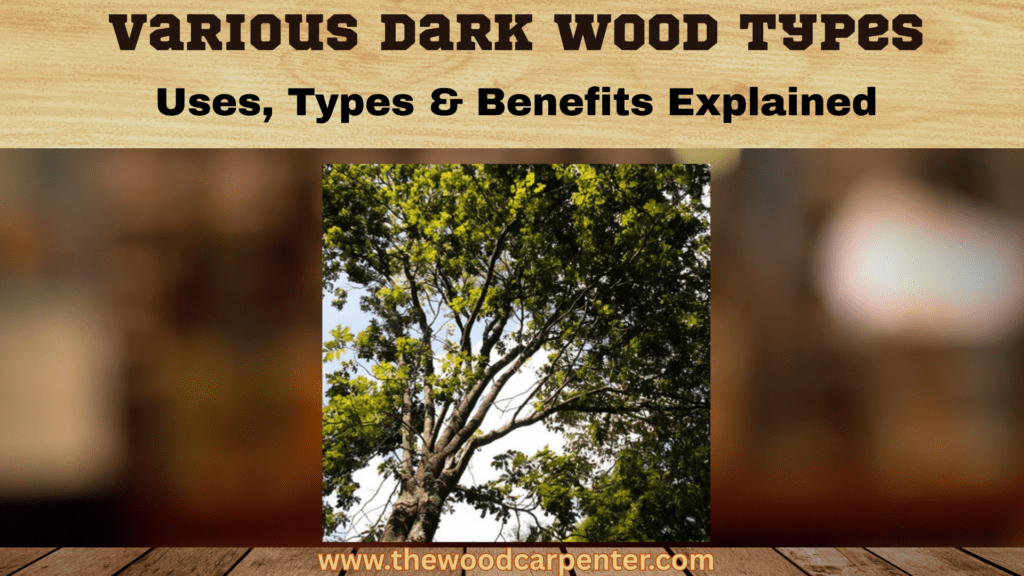
Rich dark wood has always been a beloved material to use in fine design, woodworking, and architecture. From the depth of ebony black to the warmth of walnut, dark woods offer a special blend of style, personality, and grace.
They’re beautiful as well as durable, which means they’re a wise long-term investment for your home. Opting for something such as antique heart pine flooring can bring that timeless nostalgia and value to your space.
In this guide, we’ll break down some of the most popular dark woods, spotlight their distinguishing features and advantages and provide you with some inspiration for bringing them into your home or office.
What Is Dark Wood ?
Dark wood is natural shade from brown to black created by different species of hardwood. These are mostly heavy, very hard, and very durable woods well adapted for both constructional and decorative uses. Some woods naturally are darker (like ebony and walnut); others can be stained or treated to become dark (like oak or cedar).
Get the look Dark woods instantly evoke luxury and timeless glamour. They age gorgeously — often becoming richer in tone as time goes by, like fine wines.
Popular Types of Dark Woods
Ebony
Appearance: Nearly jet black with a rich, creamy head.
Properties: Extremely heavy wood that’s stable, insect and termite resistant.
Uses: High-quality furniture, inlay work, musical instruments.
Pro: Brings a unique depth and richness.
Note: Extremely difficult to work because of its density and price.
Mahogany
Appearance: Dark, reddish brown with a fine grain.
Properties: Strong, durable, rot-resistant.
Uses: Quality furniture, framing, veneer, boats, instruments.
Pro: It’s workable and less expensive than the more exotic species.
Walnut
Appearance: Heartwood is chocolate brown, sapwood is lighter in colour.
Properties: Very tight but very workable, very sound.
Uses: Cabinets, flooring, veneers, gunstocks, fine furniture.
Wenge
Appearance: Dark brown with bold black streaks, occasionally almost black when finished.
Properties: Very dense, durable, termite-resistant.
Common uses — Flooring, high-end joinery, paneling, furniture, instruments.
Advantage: Creates dramatic, modern interiors.
Teak
Appearance: Ranges from a golden to medium brown that will darken with age.
Properties: Very tough, weather- and rot-resistant, stable.
Uses: Outdoor furniture, boats, carvings, flooring.
Pros: Ideal for use outdoors due to natural oils.
Charred Wood (Shou Sugi Ban)
Appearance: Burn finished in deep black color Textured.
Properties: Enhanced durability, insect resistance.
Applications: External Wall, Feature Wall, Modern Walling.
Pros: A striking, environmentally friendly, easy-care choice.
Key Properties of Dark Woods
Dark hardwoods catch your eye not only for their color but also their play. Common traits include:
Strength & Density – Most dark woods are slow-grown hardwoods, which means they are very long-lasting.
Durable – These can last pretty much forever if well maintained.
Resistance – Some are naturally resistant to rot, moisture and insects.
Aging Gracefully – Dark timbers tend to age well and acquire richer hues which add to their appeal.
Versatile – Ideal for flooring, cabinetry, furniture, cladding and high-end accents.
Advantages of Using Dark Wood
Luxurious Appeal
Dark wood creates a sense of sophistication and elegance unmatched by lighter tones.
Timelessness
Unlike fleeting design trends, dark wood remains classic and relevant across generations.
Durability
Their density and resistance ensure they withstand heavy use, making them ideal for flooring, furniture, and structural applications.
Design Versatility
Dark woods blend seamlessly with both modern minimalism and traditional luxury.
Practical Benefits
- Warm underfoot in flooring applications.
- Hides dirt and scratches better than lighter woods.
- Indoor, outdoor projects.
Design Tips for Using Dark Wood
Use Contrast Wisely
Combine dark, wooden floors or furniture with light walls, ceilings, and/or fabric to help balance and lighten the space.
Add Accents
Add pops of bright colour, some metallic accessories or some soft texture to avoid spaces feeling too dark and ‘heavy’.
Mix Wood Tones
Dark woods, such as walnut or wenge, are well suited with lighter timbers, such as ash or oak, to add depth and interest.
Modern Applications
Black woods work particularly well in modern kitchens, high end bathrooms and feature walls. Install them for cabinetry or islands for high drama.
Maintenance
Frequent dusting, followed by an application of either a high-quality paste wax or polish, and a once- or twice-a-year application of oil and/or varnish will help to preserve the natural beauty of the wood.
Comparison of Popular Dark Woods
| Wood Type | Appearance | Key Properties | Common Uses | Pros | Cons |
| Ebony | Jet black, smooth finish | Extremely dense, stable, insect-resistant | Luxury furniture, inlays, instruments | Elegant, rare, very durable | Expensive, hard to work |
| Mahogany | Dark reddish-brown | Strong, rot-resistant, stable | Furniture, cabinets, boats, veneers | Durable, workable, moderately priced | Heavy, sustainability concerns |
| Walnut | Chocolate brown heartwood, lighter sapwood | Dense yet easy to work, stable | Cabinetry, flooring, veneers, carving | Rich aesthetic, versatile | Costly, color variation |
| Wenge | Dark brown with black streaks | Very dense, termite-resistant | Flooring, luxury joinery, paneling | Modern, stylish, long-lasting | Difficult to work, heavy |
| Teak | Golden to medium brown (darkens over time) | Weather- & rot-resistant, oily surface | Outdoor furniture, boats, carvings | Outdoor durability, low maintenance | Expensive, dulls tools |
| Charred Wood (Shou Sugi Ban) | Black, textured burnt surface | Enhanced durability, insect-resistant | Exterior cladding, feature walls | Eco-friendly, bold look, low-maintenance | Limited to specific finishes |
| Rosewood (extra) | Dark brown to purplish hues | Dense, stable, aromatic | Luxury furniture, instruments, veneers | Exotic, beautiful grain, durable | Expensive, often restricted |
Dark Wood Trends in 2025
Dark woods woods are also coming back in a big way in contemporary design. Interior designers highlight:
- Walnut kitchens with a contrast of light countertops.
- Black floors with white or pale walls.
- Wenge or charred wood feature walls for added drama.
- Sustainable sourcing being prioritized — seek out dark woods that are FSC-certified.
FAQs About Dark Woods
1. Is dark wood expensive?
Yes, most dark woods, such as ebony and walnut, are high end cause they are rare, hard and in demand. But simply stained oak or mahogany are cheaper options.
2. What is the best dark wood for outdoors?
The natural oils of teak are the best choice, due to the teak’s weather resistant longevity. Burnt wood (Shou Sugi Ban) is a popular option as well for exterior cladding.
3. Do dark wood floors make a room appear smaller?
They can — as long as they are balanced with light walls, ceilings, or cabinets, or maybe large windows that will bathe the space in natural and allow it to feel airy even when the floor may be dark.
4. How Do You Care for Dark Wood Furniture?
This only needs to be wiped down regularly with a soft towel, kept dry, and oiled or polished to maintain its finish.
5. Is it possible to darken lighter woods?
Yes, you can stain species such as oak, cedar and ash to resemble the appearance of natural dark woods.
Final Thoughts
Dark wood is more than a material: It’s a declaration of luxury, long-term thinking, timeless design. Whether it’s the black as night ebony, walnut’s fine rich tones or cool charred wood never will a timber give your project such original character.
But when used thoughtfully — contrast, texture and careful placement are still key — they can make for interiors that feel both modern and enduringly classic.
Whether you are building a new home or renovating and simply need to freshen up your style with a contemporary black wood stain furniture,dark wood always looks good and brings together the functions and design-no matter the years.

